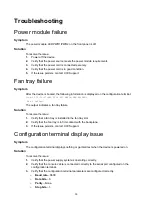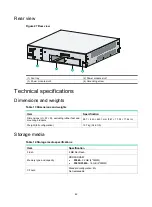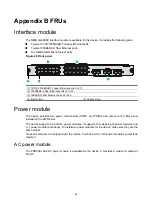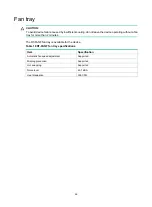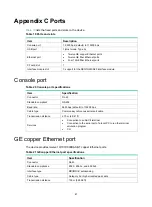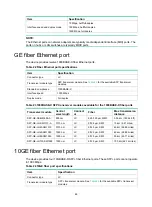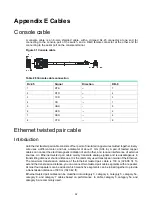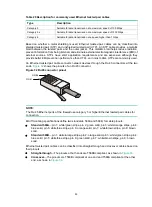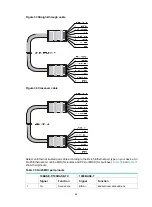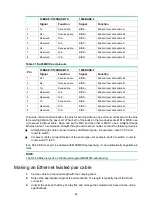
53
Table 29 Description for commonly used Ethernet twisted pair cables
Type Description
Category 5
Suitable for data transmission at a maximum speed of 100 Mbps
Category 5e
Suitable for data transmission at a maximum speed of 1000 Mbps
Category 6
Suitable for data transmission at a speed higher than 1 Gbps
Based on whether a metal shielding is used, Ethernet twisted pair cables can be classified into
shielded twisted pair (STP) and unshielded twisted pair (UTP). An STP cable provides a metallic
braid between the twisted pairs and the outer jacket. This metallic braid helps reduce radiation,
prevent information from being listened, and eliminate external electromagnetic interference (EMI) of
external sources. STPs have strict application requirements and are expensive although they
provide better EMI prevention performance than UTPs, so in most LANs, UTPs are commonly used.
An Ethernet twisted pair cable connects network devices through the RJ-45 connectors at the two
ends.
shows the pinouts of an RJ-45 connector.
Figure 32 RJ-45 connector pinout
NOTE:
The RJ-45 Ethernet ports of the firewall use category 5 or higher Ethernet twisted pair cables for
connection.
EIA/TIA cabling specifications define two standards, 568A and 568B, for cable pinouts.
•
Standard
568A
—pin 1: white/green stripe, pin 2: green solid, pin 3: white/orange stripe, pin 4:
blue solid, pin 5: white/blue stripe, pin 6: orange solid, pin 7: white/brown stripe, pin 8: brown
solid.
•
Standard
568B
—pin 1: white/orange stripe, pin 2: orange solid, pin 3: white/green stripe, pin 4:
blue solid, pin 5: white/blue stripe, pin 6: green solid, pin 7: white/brown stripe, pin 8: brown
solid.
Ethernet twisted pair cables can be classified into straight-through and crossover cables based on
their pinouts.
•
Straight-through
—The pinouts at both ends are T568B compliant, as shown in
.
•
Crossover
—The pinouts are T568B compliant at one end and T568A compliant at the other
end, as shown in
PIN #8
PIN #1

